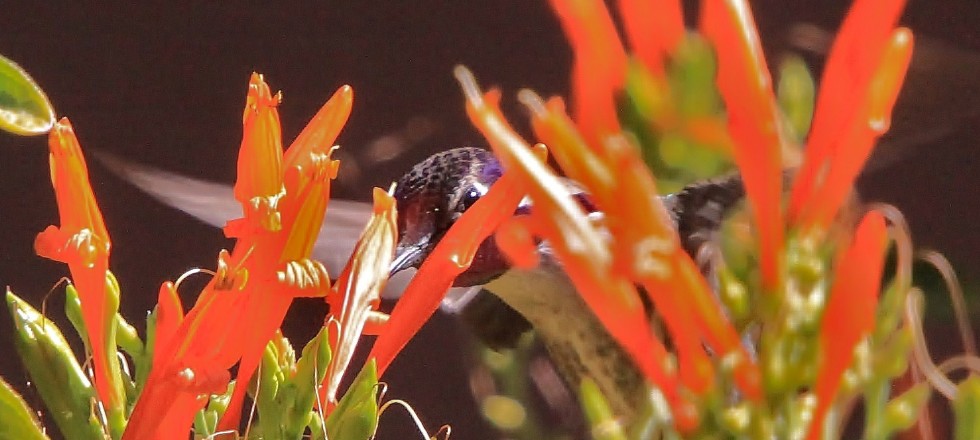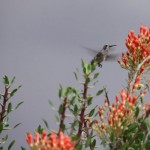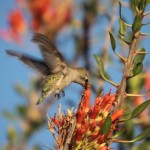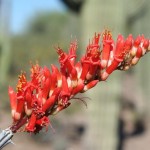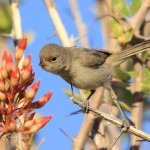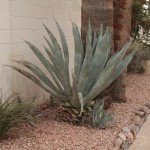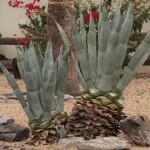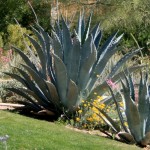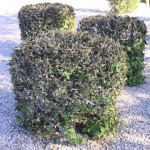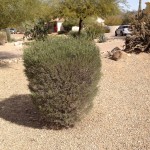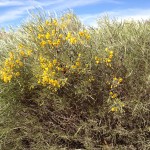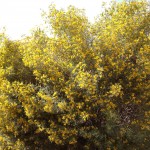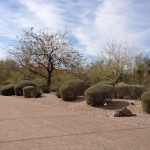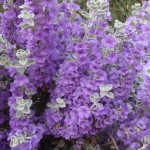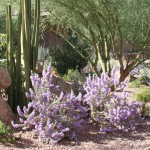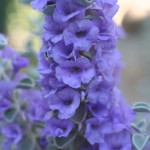Ocotillos in the landscape
Ocotillos (Fouquieria splendens) are used as stunning accent plants in our desert landscapes. These plants develop multiple wand-like stems from the base, creating their characteristic impressive form that can range from 6 to 30 feet in height. The Ocotillo is a great example of the drought-deciduous adaptation to our harsh desert environment. It can drop its foliage multiple times in a summer, looking quite lifeless, and sprout verdant new leaves within 24 to 48 hours after a good soaking rain. Our native Ocotillo typically blooms in the spring, producing tight clusters of brilliant orange-red waxy flowers at the stem tips. These nectar-laden tubes certainly attract the hummingbirds. Even when not in bloom, hummers favor the stem tips for perching and keeping an eye on everything in the garden.
If you are planning on an Ocotillo addition for your garden be aware that they are available as bare root or potted/boxed plants. Bare root specimens are generally less costly, but you have to obtain them from a trustworthy source to insure that they have not been sitting out of the ground for too long and you need to know how to properly plant and care for them. Seed-grown or field-grown Ocotillos are higher priced, but the root system is developed and you can be ensured that the plant will establish quickly. These can range from small 1 gallon size to large boxed specimens.
Ocotillos are often mistakenly considered succulents. Unlike some of their relatives from further south in the Sonoran Desert (the Boojum for example), they are not able to store water in their tissues. They are in fact shrubs and should be cared for as you would other desert shrubs. Include them on the shrub line of your drip irrigation system. Never prune your Ocotillo, as this will destroy its characteristic form by causing unnatural branching of the individual stems. If one is over-reaching its bounds, tame it by removing the errant branches at the base of the plant.
If you suspect that your Ocotillo is dead, look for green within the thorny stems. You can carefully cut away a small piece of the outer bark with a clean sharp knife. If you discover green tissue, the plant is alive. A stem that is dry and brown inside is dead, and you should test some others as well. If it is a recently planted bare root plant that you are worried about, remember that it can take them months to get new roots developed and “come alive” with new foliage.
If you don’t currently have an Ocotillo in your landscape, consider an addition that can become a dramatic focal point to be enjoyed by you and your hummingbird friends.
Kirti Mathura
Building Beautiful Gardens – It’s What We Do
Cesar Mazier Landscapin g & Consulting, Inc. (CML) is a landscaping & consulting firm headquartered in Phoenix, Ariz. CML is dedicated to preserving the beauty of the Sonoran Desert, while introducing desert landscaping, and building beautiful gardens in properties.
g & Consulting, Inc. (CML) is a landscaping & consulting firm headquartered in Phoenix, Ariz. CML is dedicated to preserving the beauty of the Sonoran Desert, while introducing desert landscaping, and building beautiful gardens in properties.
We provide design, consultation, landscape installation, hardscape installation and landscape maintenance services for our discriminating residential and commercial clientele.
Our team members are consistently instructed in seminars conducted by Cesar Mazier on subjects such as botany and horticulture, irrigation, pruning techniques, planting and other relevant subjects. These field and indoor classroom seminars ensure we remain the most qualified in our field, and perform the most precise work to Cesar’s standards.
Cesar founded the company in 2002 after serving an illustrious career as director of horticulture for Desert Botanical Garden in Phoenix, Ariz. for 16 years, following his career as a scientific field researcher in Honduras.
Detrimental Agave Trimming continues…
Agave trimming is a common practice that has spread rapidly as a disease primarily due to lack of knowledge. Forms of agave trimming can be seen in larger species such as Agave Americana, Agave Salmiana, Agave Weberi to name a few.
The origin of agave trimming came from the harvesting of agaves for the production of tequila and mescal in throughout various parts of Mexico. This practice is performed when the plants are ready to be processed at the distillery a time when all the leaves must be removed for transportation purposes. To put this in perspective, a harvested agave look like our beautiful Hawaiian pineapple.
In desert communities across the southwest, the agave is primarily used for landscape enhancement. And while agaves are common to this region only a few dozen out of more than 200 hundred different species are being used in the average desert landscape.
Trimming agave leaves causes an enormous amount of stress on the plants specially during the hot season. Agaves spend all their life storing water and food in their leaves for one beautiful display. This is something that may happen once in a lifetime.
During the dry season, agaves make use of their leaf storage of water and food to support themselves. Not having the bottom leaves weaken agaves and they becomes susceptible to diseases and snout weevil attack. Other lower leaf functions include protecting the plant trunk and the roots from the inclement sun.
For those new to phoenix (homeowners and gardeners alike) the agave and its majestic shape can be an attractive asset to any landscape but not knowing the approrpiate care techniques can significantly affect their overall lifespan.
Advice From an Expert
Cesar says to make sure that you choose the right location for your agave so it can express its unique beauty and grow to its fullest potential. If you know that your agave is going to be very large, make sure you relocate it to a better place. For a consultation with Cesar please call 602-265-0920.
No flowers today?
Shrub trimming is one of the most common practices in the landscaping field across the Phoenix metropolitan area. Unfortunately, this simple practice can be unjustifiably brutal. The lack of horticultural knowledge creates round balls, square and rectangular shrubs. For many, the appeal of round or square plants falls into the artistic category. But, the end result of this practice is always the same; a plant with an enormous amount of dead branches and an unhealthy look. The hardest part for a plant is that when it is about to bloom, after spending a great deal of energy getting ready for its big debut, it gets trimmed by a machine that doesn’t know what it’s doing!
Water Conservation
Cesar Mazier Explains Water Conservation for Your Desert Landscape.
When creating a desert landscape there are obviously many variables to keep in mind. In this short video, Cesar Mazier explains how to build a beautiful desert landscape using simple water conservation techniques.
https://
